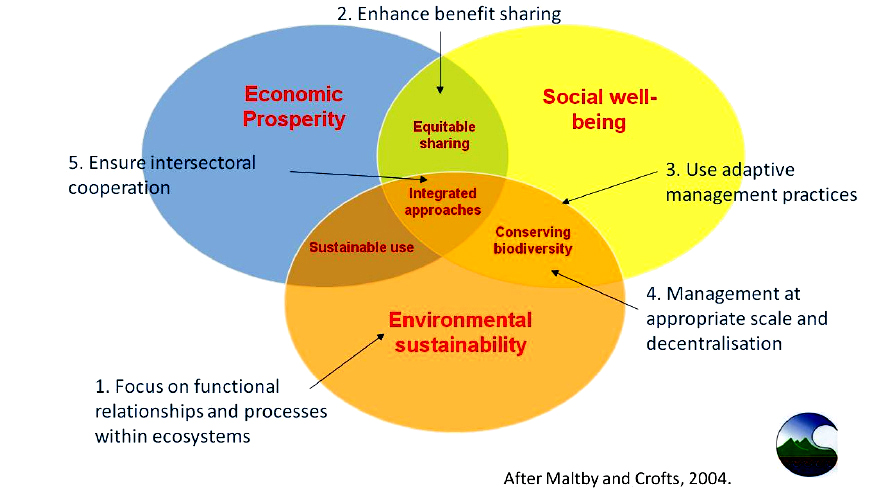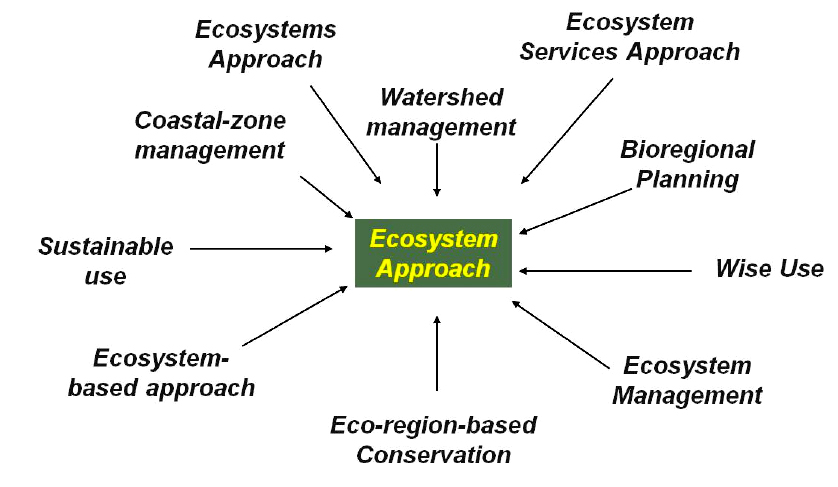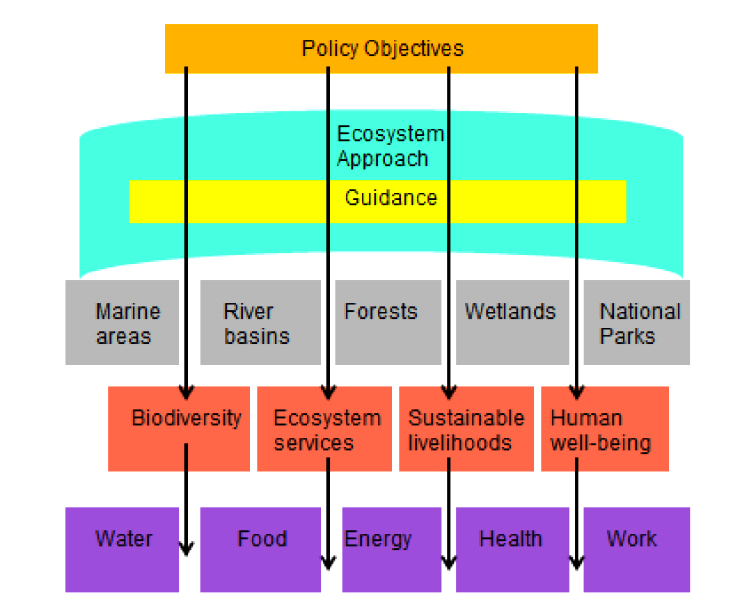Prof. Edward Maltby and Prof. Mike Acreman of the The Sibthorp Trust, University of Liverpool UK and Centre for Ecology and Hydrology UK, with acknowledgement for funding support to the UK Government Department for Environment, Food and Rural Affairs presented a paper at the 2016 IUCN World Conservation Congress.
You can hear an audio version of the presentation here.
1. Clarification
Structure, outcomes and guidance for the Ecosystem Approach
Despite the significant evolution of thinking around the Ecosystem Approach over 20 years, considerable debate has perpetuated over the exact meaning and implications of its application. There remains a need for further clarification and guidance to realise its full potential in a changing world. The Sibthorp Trust has now revisited the process it had initiated in the mid1990s, which was originally to provide guidelines for ecosystem management that questioned the historic and accepted norms of conservation. The new challenge was to assess progress and attempt to provide further guidance on the practical implementation.Confusion has arisen for many reasons but especially because of the historic understanding of the ecosystem concept and also because of the apparent similarity to numerous other concepts. Proponents of other named concepts are naturally reluctant to abandon what they have believed to be good innovative practice, often hard won after years of endeavor, emanating from different disciplines and/or backgrounds. Competition over terminology is not helpful in this case. It can be avoided if the Ecosystem Approach is seen as an overarching conceptual framework informed by a set of principles all of which should atleast be considered in its application. It is not the case that there are different ecosystem approaches, but that there are many different ways of delivering the ecosystem approach (emphasizing the flexibility of the methodological framework). The ultimate test of success is the outcome of application not the terminology, but qualified by the experiences of implementation, which adds real value to our approach to ecosystems and environmental management. It is hoped that the uncertainty raised by questions such as those above may be resolved through the guidance offered here. We acknowledge the contributions of the multidisciplinary cohort that contributed to this work who are attributed at www.sibthorp.org.uk
2. Relationships
There are many approaches and activities that fully or partially embrace the same concepts as the Ecosystem Approach and this has led to ambiguity of which approach to follow. Indeed, one of the results (not necessarily anticipated) of the successful incorporation of the concept within policyorientated statements and associated documentation is that there is considerable variation in the precise interpretation of the Ecosystem Approach and what exactly constitutes its implementation. Interpretation has been further confused by conflation with other terms including ‘ ecosystem services approach’ and treating natural resources as ‘ capital’ significant for social and economic welfare.
3. Need for new guidance
Terminology can be confusing
Questions frequently being asked include:
How does the concept relate to others that appear to have the same overarching aims or principles?
Is it feasible or even desirable to replace existing approaches (especially where they already advocate a strongly integrated framework) with the Ecosystem Approach?
Is partial delivery of the Ecosystem Approach ( as defined by the CBD) through the strengthening and reinforcement of other approaches (by the more formalised application of at least some of the EA principles) sufficient to qualify as its application?
Does it matter whether we refer to ‘ the” or ‘ an” ecosystem approach or as singular or plural (approaches)? The Ecosystem Approach may appear to many as common sense, but it needs to be more explicit. Even if common sense, it is easy to miss vital steps in any approach that could render results invalid or at worse counter-productive.
Different people and societal groups have often fundamentally divergent views of the same environmental resources so an agreed common approach can help identify and potentially resolve differences
The guidance is required to achieve a more coherent approach to diverse policy objectives.
4. Audiences
While this guidance is highly relevant to those charged with the formulation or interpretation of environmental policy, it is arguably even more important that many others outside that remit should appreciate the relevance of the guidance offered. One of the overriding constraints in the successful delivery of the Ecosystem Approach identified during Sibthorp II was the conventional sectoral organisation of government. “ The environment does not work that way” Hence, this is a guide to guiding others in a wide range of policy areas, not just those with immediate or direct links to nature and the environment.
The application of the Ecosystem Approach requires the awareness of policymakers across all sectors of government and those agencies charged with interpretation and delivery together with the increasingly important third stream organisations with the opportunity for implementing innovative delivery mechanisms. It is intended also for academics, scientific and other technical specialists in institutions and commercial consultancies as well as educators (including both universities and schools).
Above all it provides information and guidance to the wider cohort of groups or individuals including the business sectors who knowingly or unknowingly have a vested interest in how the natural environment is or should be managed. The full range of so called stakeholders are often marginalised or incorporated only by lipservice in policy delivery.
It is hoped that by better communication and understanding of the Ecosystem Approach a greater inclusiveness within civil society can be achieved.
5. Opportunities and Barriers
Despite considerable commitment and activity to address natural resource management issues, many remain unsolved, get worse or generate additional problems. The main barriers (but also the opportunities) to delivering an approach that effectively and coherently integrates the natural environment and human economy and wellbeing are:
• Institutional rigidity and inherent difficulties in working across sectoral interests. Institutional structures need to match ecological, social and economic processes operating at different spatial and temporal scales and to address the linkages between those scales. This polycentric approach to governance provides for greater experimentation, learning, and crossinfluence among different levels and units of government, which are both independent and interdependent, to develop flexible institutional arrangements . Such arrangements are difficult to implement, as they require ways of ensuring local organisations interact with each other and with organisations at different levels. It requires public participation across a diverse set of interest groups operating at different scales, from local beneficiaries, to local government, to regional and national organisations and to the international level. The model has been proposed for catchment management but needs to be fully tested.
• Fundamentally divergent views of the same environmental resources are sometimes formed by different stakeholders. Not least that renewable resources are infinite and the phenomenon of shifting baselines whereby stakeholders accept a degraded state and a lower flow of benefits as normal. As fishermen and farmers amply demonstrate, these apparently ‘ turkeys voting for Christmas attitudes’ are very hard to shift.• Lack of understanding and knowledge amongst many stakeholders. The key impediment to balancing this perspective is the lack of both public and government understanding of the often hidden and delayed costs in terms of environmental damage that sooner or later need to be paid.
• Lack of consistent measures of progress. Measures of progress and wellbeing must be measures of the degree to which society’s goals (i.e., to sustainably provide basic human needs for food, shelter, freedom, participation, etc.) are met, rather than measures of the mere volume of marketed economic activity, which is only one means to that end. We need indicators that promote truly sustainable development i.e. development that improves the quality of human life while living within the carrying capacity of the supporting ecosystems.
• Short term thinking. Adoption of strategies that produce more or less immediate realisable gains and demand driven economics may yield only shortterm solutions while resulting in irreplaceable environmental losses. Benefits are usually analysed on a sector basis and without full assessment of the long term environmental dis-benefits. “Overriding economic considerations or national interests” is a phrase often used to excuse the lack of integrated thinking.
• Lack of data to enable consideration of the ‘full’ valuation (including but not limited to economic valuation) of ecosystem services and absence of proven innovative mechanisms to rectify imbalances in responsibility for their maintenance and/or enhancement such as through Payment for Ecosystem Services (PES).
• Land ownership focused on limited/single outcomes.
• Lack of nonmonetary evaluation methods and insufficient knowledge about some processes underpinning ecosystem services.
• Crosssectoral thinking limited by insufficient decisionmaker training/experience(linked to all the above).
• Government domestic policy is generally focused on priorities such as the economy, employment, health, education, poverty and welfare, terrorism and conflict, taxation and trade, which tend to be seen (erroneously) as completely unconnected with issues concerning the natural environment and specific questions of ecosystem management.
• Engagement between government and the private sector is still limited with the possible exception of the water industry and this limits the depth of appreciation by the general public of the reality of the ecological-economic-social linkages. The failure not to connect underpins global scale priorities such as poverty alleviation and improvements in water quality and health. The political time scale is generally shortterm measured by popular voter reaction to the perception of immediate benefits but environmental management must be for the longterm if we are to achieve the sustained benefits of natural resources. We are reminded almost daily by periodic shortages or unprecedented rates of price increase(notwithstanding the current downturn in world oil prices) that the nexus of water, energy and food (http://www.thenexusnetwork.org/) will present as far-reaching challenges to society in coming years. Such challenges are already manifest in terms of food riots, disease, poor sanitation, malnutrition and poverty throughout the developing world.
6. 20 Points of new Guidance
G1 The Ecosystem Approach will be most effective when it is focused on actual and clearly defined issues.
G2 A major aim should be closer collaboration across government departments, agencies, business, academics and other knowledgeholders and all elements of civil society.
G3 Encourage changes in attitudes from purely material wealth to recognition of wider individual and community wellbeing.
G4 Management should recognize the value of the multifunctional aspects of land and seascape.
G5 Objectives should be long-term.
G6 At least initially it will be essential to work within existing sectoral arrangements.
G7 Identify clearly who can contribute to making the necessary changes.
G8 There is a need for a practical means of intersectoral cooperation and to generate a willingness to work together.
G9 The concept of the EA can be transferred, without necessarily substituting the detailed terminology, where it enhances or improves existing integrated approaches. But where current integrated approaches are trusted and generate satisfactory outcomes, transfers may be unnecessary and simply ‘fine-tuned’.
G10 A clear communications strategy is an essential prerequisite of delivery.
G11 identify appropriatescale demonstration/exemplar projects.
G12 Recognise traditional knowledge systems and how related decisions are made.
G13 Ensure quality level/certainty of information is defined.
G14 Provide an inventory of sources of information to guide users and avoid overload by helping to sift available information.
G15 Review the full range of available tools to help implement the Ecosystem Approach most appropriately within the contextual (spatial and temporal) framework of the problem addressed.
G16 Making knowledge available and enhancing the ability to use it.
G17 Work at the appropriate spatial and temporal scale, reflecting the nature of the problem or issue being addressed.
G18 Take note of unintended results of actions taken in implementation.
G19 Ensure provision to collect sufficient information to enable adaptive management, post project appraisal, record learning experiences and communicate outcomes.
G20 Identify where possible economic gains and/or cost savings for different sectors, especially industries/private sector/public of implementation of the ecosystem approach.
7. COMMUNICATIONS
Any communications should begin with a clear strategy that should consider the following steps.
Define a clear reason for communicating. Why are things not working as they are? Who can effect change and thus who is the target for communication? What is wrong with any current communications? What are the external challenges to communication Understand the target audience, their role in the subject area, their likely level of knowledge of technical aspects of the subject, their aims and objectives and their general culture. It is particularly important to analyse the current behaviour and reasons for this and why you consider this could be deficient or inappropriate or has potential to improve Define how you would like the behaviour of the target audience to change. This will clearly be related to acceptance of the new idea, approach or method and implementation in their particular sector and role.
Examine what is likely to be most the successful media to reach them, get them to take notice and change their behaviour. This might be a technical briefing paper, glossy brochure, newspaper article, radio interview, per or one¬toone discussion. Collate the communication information needed that will provide the appropriate description of the approach and any necessary evidence to support it with clear aims and objectives for the target audience and guidance on implementation. This may require translation of technical information into the language to which the audience is likely to respond positively, including adaptation of EA concepts to other framework with which they are familiar. Construct the appropriate message, produce the communication and action it. This should include the benefits of action to the target audience and why it is necessary and why there will be better outcomes. Unique selling points are particularly powerful.
Communication needs to be based on reallife situations with practical examples.
Follow-up and monitor success.
Checklist for implementation of The Ecosystem Approach
1. Identify the need/problem or opportunity
2. Assess appropriateness of the ecosystem approach to deal with this(against the 12 principles and effectiveness/limitations of existing approaches)
3. Identify stakeholders, including those whose activities either create the problem and/or would be part of the solution
4. Use available information to clarify the problem/opportunity
5. Evaluate with stakeholders the practicalities, barriers and constraints to implementation
6. Identify and where feasible establish mechanisms for integrated governance
7. Define clear objectives and evaluation criteria
8. Codesign an action plan and responsibilities
9. Secure the funding necessary for the delivery of the plan and operationalization of actions. But ensure funding is unconstrained by sectoral interests
10. Collect necessary new information and undertake scenario analysis of different actions/trade-offs
11. Design instruments for resource management (e.g. fishing quotas) and required enabling mechanisms such as PES and/or other incentives
12. Monitor, evaluate,and adapt where necessary to ensure desired outcomes.





